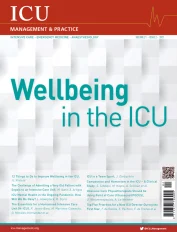
ICU Management & Practice, Volume 21 - Issue 2, 2021
Download PDF |
 |
| PRINT OPTIMISED |
Download PDF |
 |
| SCREEN OPTIMISED |
Editorial
Wellbeing in the ICU
Healthcare workers across the world have been facing significant challenges due to the COVID-19 pandemic. In particular, critical care workers have had to deal with several issues, including a surge of seriously ill patients, shortages of staff and resources, long shifts, exhaustion, risk of infection, fear of transmission to family, constant exposure to illness and the tragedy of patient deaths. In additi...
Cover Story
12 Things to Do to Improve Wellbeing in the ICU
An overview of strategies and measures that can be implemented to improve wellbeing of staff and patients in the ICU. This is the first principle of wellbeing in the ICU and should be written in large letters when one enters an ICU. Wellbeing must concern first and foremost the patient. The patient should be positioned, figuratively, at the centre of the ICU room, with the focus of all members of the ICU...
The Challenge of Admitting a Very Old Patient with Sepsis to an Intensive Care Unit
Sepsis incidence in very old patients is high and related mortality and morbidity are a major health concern. Frailty and severity of illness, not just age or sepsis diagnosis, are the determinant factors in outcome. Early identification and treatment are decisive in their survival. Nowadays, we are facing some important facts: there has been a global increase of sepsis worldwide over the last decades (Ru...
ICU Mental Health in the Ongoing Pandemic: How Will We Be Okay?
After a year of this pandemic, this article explores what we currently understand about the psychological impact experienced by ICU teams and provides practical guidance to help build personal and team resilience as the journey with COVID-19 continues with no end in sight. When COVID-19 emerged as a new pathogen, the pictures and stories of the devastation it was bringing focused attention on the mental h...
The Essentials for a Humanised Intensive Care Unit (H-ICU)
This article highlights the key points that fall under the meaning of humanisation as part of the ICU Liberation bundle. How would a patient describe their stay inside an Intensive Care Unit (ICU)? Would it be cold, lonely, a place full of uncertainty? Painful, uncomfortable or scary? The length of stay (LOS) in the ICU may be the most traumatic experience a person can endure. A duel between life and deat...
ICU is a Team Sport
The importance of creating a psychologically safe workplace and the need for a fundamental shift in workforce culture to foster compassionate leadership and collaborative approaches to delivering safe, supported care. I write this almost one year to the day after the UK announced its first coronavirus pandemic lockdown. The next few months were full of confusion, uncertainty, and fear. The world was faci...
Compassion and Humanism in the ICU – A Clinical Study
Importance and Objectives To observe the impact and main contributing factors of stress, anxiety and depression among frontline staff in the intensive care units during the COVID-19 pandemic, and to determine if wellness resources are useful. Design Mixed method observational cohort study. Setting and Participants All frontline staff working in the intensive care units at one tertiary academic medical cent...
Point Of View
If It’s Good for Calcium Why Not Magnesium? Reasons to Measure iMg in the ICU
An overview of the importance of getting magnesium levels right in critically ill patients and the role ionised magnesium plays. Like all electrolytes, magnesium exists in the bloodstream in “bound” states, and in “free” or “ionised” states, which is the portion that is physiologically active. This ionised component (iMg) represents approximately 55-70% of the total Mg (tMg). Magnesium’s rol...
While Perioperative Care is Optimised, Patients Die Unmonitored in the Ward!
Patients and their families often fear surgical interventions due to possible complications during the procedure and falsely assume to have survived the most dangerous part when reaching post-anesthetic care units.1 However, postoperative hypotension more often occurs in the wards, causing myocardial infarction and death,3,4 as it largely remains undetected.5 47% of postsurgical hypotensive events are miss...
Matrix
Intensive Care Physiotherapists Should be Using Point of Care Ultrasound (POCUS)
An overview of the potential of POCUS on clinical decision making at the bedside and the need to add it as a new diagnostic tool by intensive care physiotherapists. Intensive care physiotherapists often rely on standard assessment tools, such as measures of physiological function (arterial blood gases), adequacy/quality of lung aeration through lung auscultation and the portable chest radiograph to guide...
Management
Top Five Priorities for a New ICU Director During the First Year
During the first year, the ICU director should take a snapshot of the ICU situation and invest time and resources to acquire good and real data that will drive priorities of care and management. After that, implementation of basic protocols and creating a programme to engage and protect the staff against burnout should be considered. Finally, we suggest integrating research and educational activities into...
Agenda
Agenda
MAY 5-7 EuroELSO 2021 Virtual event https://iii.hm/18rs 31 MAY – 4 JUN Blood Diseases in the ICU - Advanced Training Course Saint-Louis Hospital, Paris, France https://iii.hm/18rt JUNE 1 ISICEM e-DAY – Hemodynamic Monitoring Virtual event https://iii.hm/18ru 8-12 ICEM21 - International Conference on Emergency Medicine Virtual event https://iii.hm/18rv 9-11 Reanimation 2021 Paris, France https://i...



















